- Title: Contemplations, Mayil Hieroglyphica.
- Author: Arvindus.
- Publisher: Arvindus.
- Copyright: Arvindus, 2021-2023, all rights reserved.
- Index: 202112302.
- Edition: html, fifth edition.
- Original: Contemplaties, Mayil Hieroglyphica, Index: 202112301.
§
In this contemplation the Mayil hieroglyph, or the Mayil Hieroglyphica, shall be considered. The goal shall not be to come to closed conclusions but rather to come through the consideration to a richer general understanding of its symbology.
Now a hieroglyph is known as a figure, emblem or sign carrying a hidden meaning and as a secret or enigmatic symbol.1 The word 'hieroglyph' finds its etymological source in the Greek 'ieroglyphos', which consists of 'ieros', indicating a sacredness, and 'glyphos', indicating a carving, and a hieroglyph may thus be etymologically understood as a sacred carving.2, 3
'Mayil' is the name of the publisher of the works of Master Morya through Geert Crevits (1944-2012), and the Mayil hieroglyph then can be seen as the sacred and secret carving of the sacred and secret figure, emblem or sign of the works of Master Morya through Crevits. Just like the works the hieroglyph was given by Master Morya through Crevits.
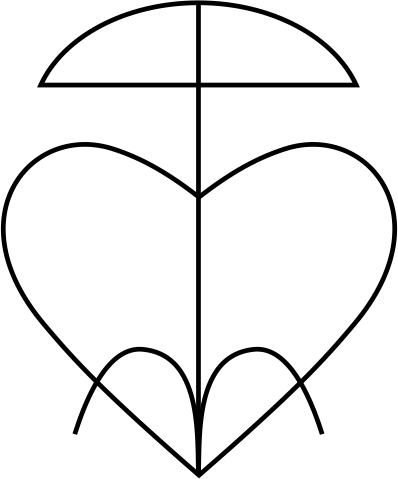
Figure 1.
About the hieroglyph Master Morya through Crevits communicated Himself: "It is best if you at a certain time let the sign of the heart that I draw every time at the end of our late evening lessons be created for a piece of jewellery, so that you carry the presence of My energy with you" and "By carrying this symbol you make it clear to the Lords of the Hierarchy that you want to cooperate for 'the divine plan of light' that exists for this earth. By this your life gets a special protection. You may also expect to receive small assignments with which you may give form to the New Time. The forces of love, protection, inspiration and intuition come live with you and create an acceleration in your evolution. You become part of a greater whole and find connection with an inner group of people to whom you belong".4
So Master Morya connects through Crevits here four forces to the hieroglyph, namely that of love, protection, inspiration and intuition. By Mayil itself the hieroglyph is graphically also divided into four parts, namely that of "heart, cross, dome and fountain".5 It can safely be accepted that the force of love in the hieroglyph is symbolized by the heart and the force of protection by the dome. That the force of inspiration then is symbolized by the fountain is also no implausible thought, and the cross in the circle as symbol of the intuition was already earlier contemplated.6 The circle is in this case then imperfectly formed by the high bow line of the dome and left and right the two outer lines of the heart. The central thought in this symbology is thereby not so much that the cross is placed in a perfect circle but rather that it is placed in a periphery. Further the cross can on itself also be taken as representation of the four compass directions which are used with navigation, which clearly connects to the navigation power of the intuition. The intuition by the way may also easily be related to the heart because it is there that just like love it is found, and in this latter case the cross is not related to any of the mentioned forces. However to relate the four forces to the four parts of the Mayil hieroglyph we here see the dome as standing for protection, the heart for love, the fountain for inspiration and the cross for intuition.
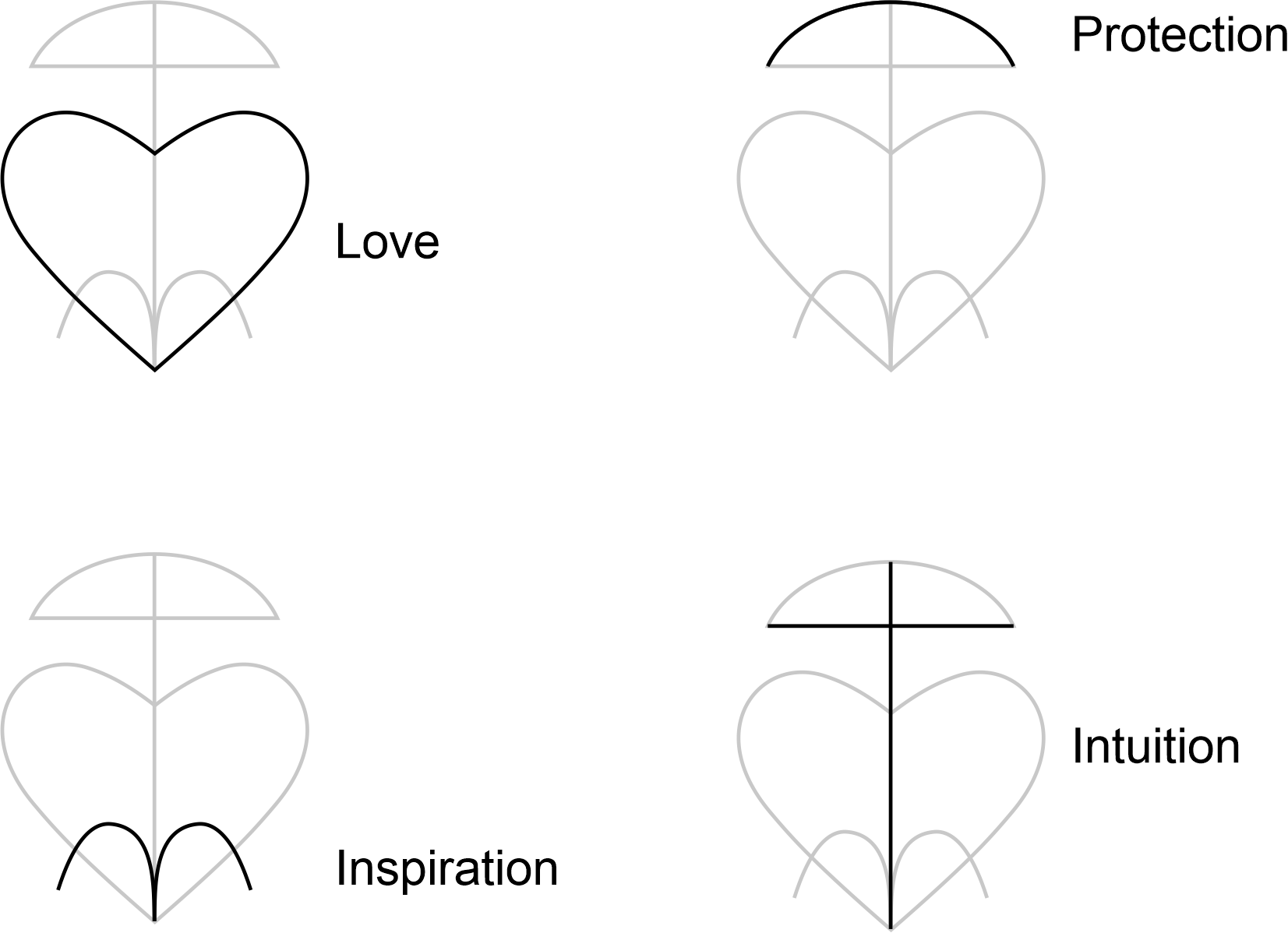
Figure 2.
Now in Tamil 'Mayil' means 'peacock', and publisher Mayil then uses itself a peacock image as logo.

Figure 3.
And with some imagination such a peacock may also be seen in the Mayil hieroglyph. In this the spread open tail of the peacock is seen in the heart, its crest in the dome and its legs in the fountain. It is however also possible to see in the heart the body, in the dome the tail and in the fountain again the legs.

Figure 4.
Now Geert Crevits did not only have contact with Master Morya but also with the Avatar Swami Premananda (1951-2011), whom he also met physically. And Swami Premananda had thereby given Crevits the spiritual name 'Arjuna'.7
Arjuna is a Hinduist personage from the Mahabharata and the well known Bhagavadgita. He is a prince and a warrior who in his battle is supported by Krishna, who is an incarnation of the god Vishnu.8, 9 Krishna is like Christ an incarnation of divine love,10 and when He is depicted together with Arjuna we see both mostly on a chariot. This chariot is traditionally depicted with a dome and as harnessed with horses of which Krishna has the reins in hand. Symbolically in this image stand the chariot for the body, the horses for the senses, Arjuna for the individual soul and Krishna for the divine soul.11 Below we see an image that was also used on the memorial card of Crevits' passing away.
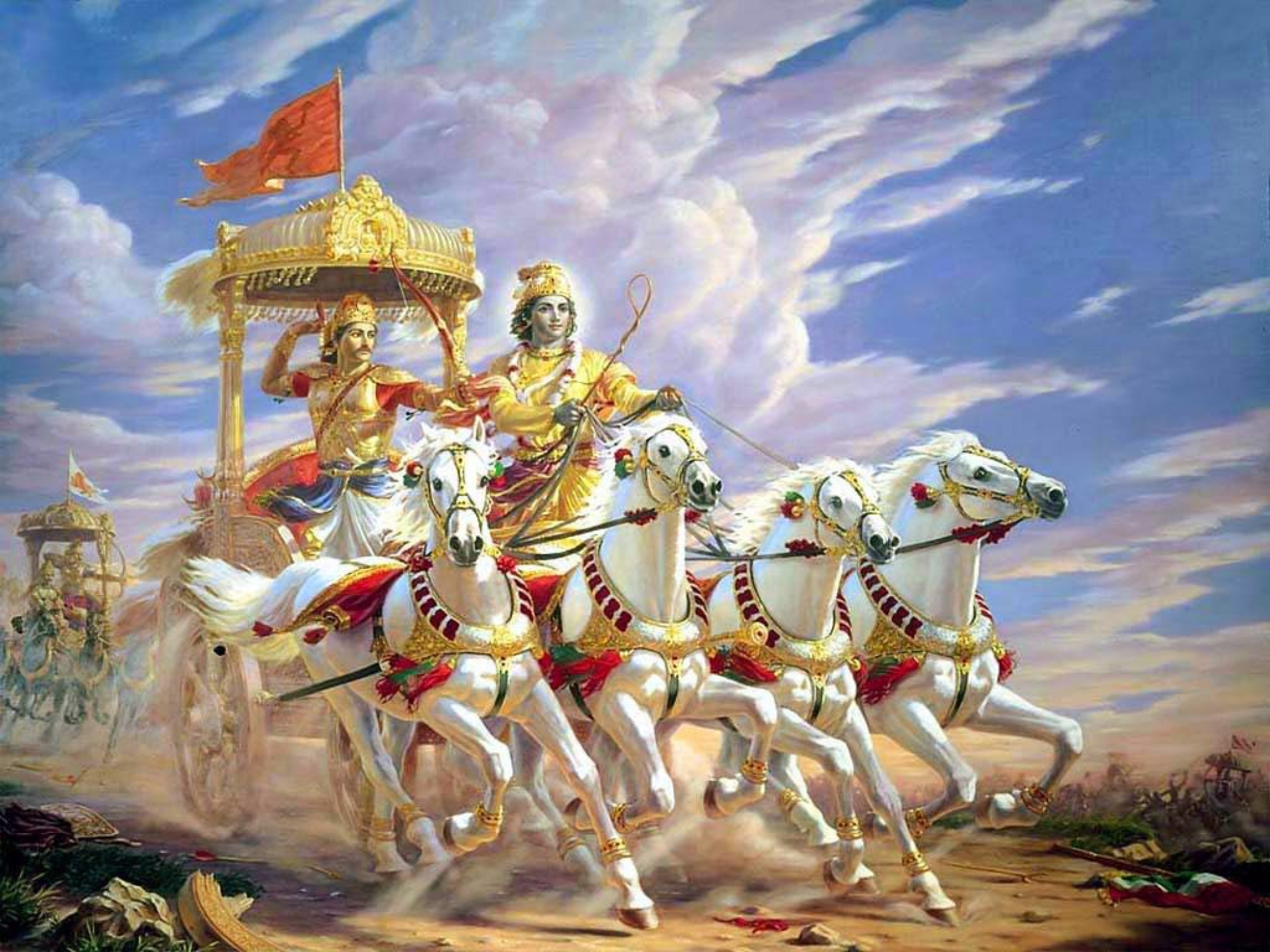
Figure 5.
Looking at the above we may in the Mayil hieroglyph easily see a symbol thereof. The dome (together with the lines of the cross) we see thereby as dome of the chariot and the heart as Krishna as god of love. With its two half circles and single point the heart may however also be a symbol for the unity in battle of Krishna and Arjuna, for the unity in work of the divine soul and the individual soul, for the unity in work of Master and disciple. The lines of the fountain then may conclusively stand for the reins, the horses or the wheels of the chariot, or all three as the entire chariot. Interesting still to mention in this interpretation is that Master Morya, a Lord of Love, once Himself was a prince and a warrior,12, 13 and the Mayil hieroglyph may in line with the aforementioned then in its whole also be seen as a symbol of that warrior of love.

Figure 6.
Initially in this contemplation the Mayil hieroglyph was split into four parts, however as seen it may also be split into three parts, namely that of the dome, the heart and the fountain, whereby the remaining vertical line optionally functions as a string whereon the aforementioned three are strung like pearls (the horizontal line of the cross is in this vision part of the dome). Such a threefold connects closely to the teachings about threefolds of Master Djwhal Khul through Alice Bailey (1880-1949) as also to the teaching about the Trinity of Christianity. This Trinity consists of the Father, the Son and the Holy Ghost, and in the teaching of Master Djwhal Khul through Bailey the Father is related to spirit and power, the Son to consciousness and love-wisdom and the Holy Ghost to matter and active intelligence.14 In this threefold then the dome stands for the protecting power of the Father, the heart for the wise love of the Son and the fountain for the active intelligent inspiration of the Holy Ghost. In this view the graphic display of the fountain may also be seen as the wings of the dove of the Holy Ghost. The remaining vertical line in this outline then represents the alignment of spirit (as reflection of the Father), soul (as reflection of the Son) and body (as reflection of the Holy Ghost).15, 16

Figure 7.
Mentioning above the body as a reflection on a lower level of the Holy Ghost and of active intelligence the fountain may also be seen as a symbol of the fire of matter or the kundalini fire. Initially slumberingly located in the spinal base centre the kundalini at ascension or enlightenment rises up through the heart centre to the crown centre.17 The visiting of the heart centre is in the present consideration then symbolized by the two bow lines of the heart and the flowing out in the crown centre by the two bow lines of the dome. Optionally the left and right bow lines may also be seen as symbols of the ida and the pingala, whereby the middle vertical line stands for the sushumna,18 however this image we shall not work out visually here.
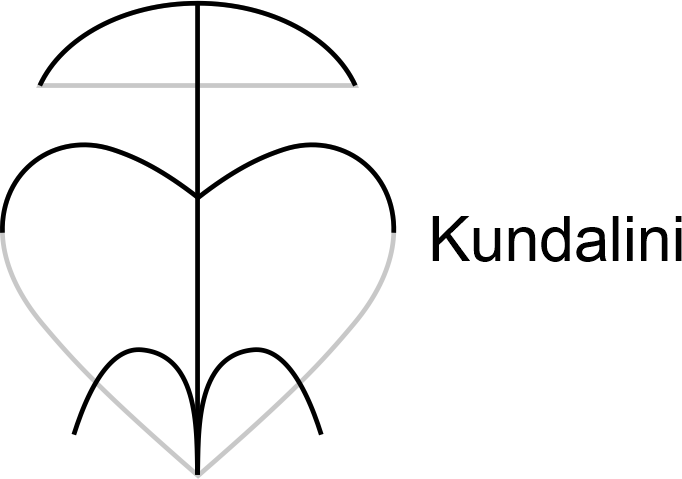
Figure 8.
Now above the base centre, the heart centre and the crown centre were mentnioned, and these are the most important centres for the threefold human. And also these centres may symbolically be seen in the Mayil hieroglyph, whereby the fountain stands for the base centre, the heart for the heart centre and the dome for the crown centre. When the dome is visualized without the horizontal line then the latter (split into two horizontal lines) may also be taken as symbol for the centre between the eyebrows, which we shall here neologistically call the 'frown centre'. Not only do the placements of the symbols coincide with the true placements in the human body but also the symbology is fitting. For the base centre is par excellence the centre where the kundalini fountain slumbers, the heart centre is directly symbolized by a heart, the frown centre is in the traditional chakra teachings symbolized by two horizontally placed flower petals and the crown centre is not only placed on top of the ball shaped head of man but also has a halo-like radiation that may be depicted by the dome.19 To be complete below the four centres instead of the three centres are depicted.
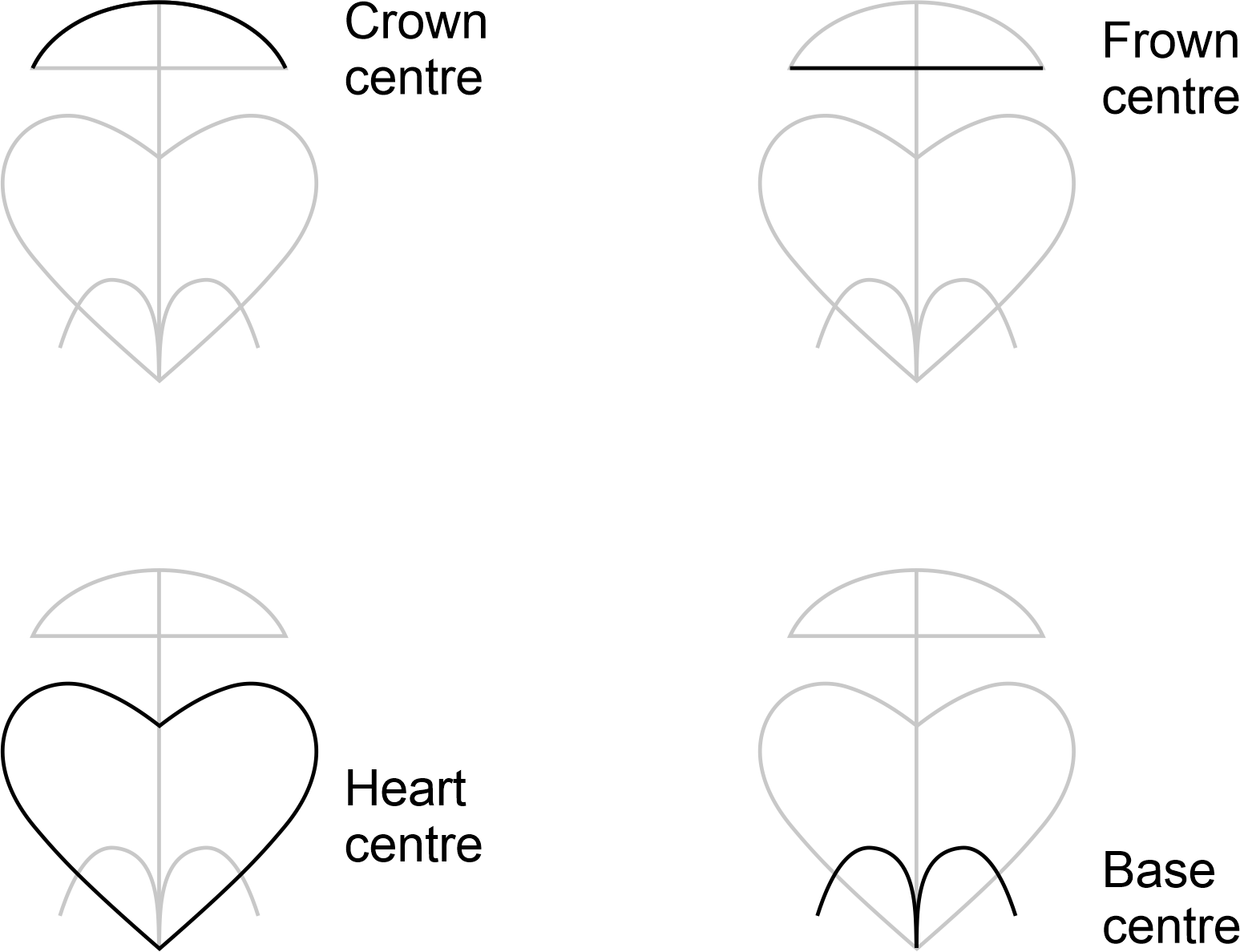
Figure 9.
Now earlier the Christan Trinity of Father, Son and Holy Ghost was mentioned, but this is not the only Christian symbology that can be descried in the Mayil hieroglyph. For the first Christian symbol that is seen therein is probably the Sacred Heart symbol.20 This Sacred Heart symbol consists most primarily of a heart that symbolizes the love of Christ.21, 22 Almost always on top of that heart a Christian cross is depicted, however there are also images wherein that cross is placed in the middle of the heart (almost like the cross in the circle or the periphery)23. The cross in short stands for the sacrifice of Christ.24, 25 On top of the heart usually also flames are shown that may stand for the fiery love of Christ but also for the fire of the Holy Ghost.26, 27 Further Sacred Heart images almost always show a crown of thorns. Mostly that crown is winded around the heart but sometimes it forms a circle around the Sacred Heart image. There are also images where the crown of thorns as an aureole is placed above the cross and the flames. This crown of thorns stands for the suffering that Christ on earth underwent.28, 29 Most times the heart also has a wound, according to the legacies made by a spear.30 From that wound according to the legacies flowed blood and water that in the Holy Heart symbol usually are also depicted, and in some cases the spear is also part of that image. The spear symbolizes the fate of Christ,31 and the blood and water stand for the purifying water of life that Christ bestows.32, 33 The last to mention element regards a ring of light rays that emanate from the Sacred Heart. These light rays symbolize the blessings that like sun rays emanate from Christ.34
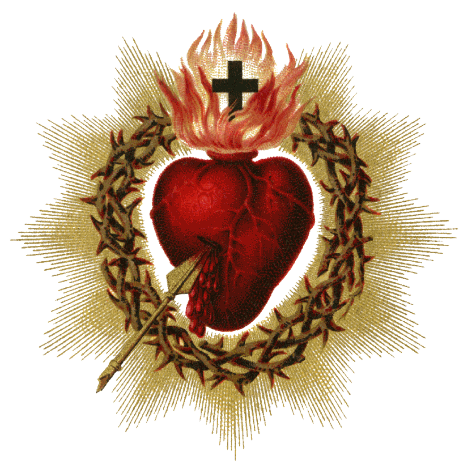
Figure 10.
Now which elements from the Sacred Heart symbol may we find also in the Mayil hieroglyph? The most prominent are of course the heart and the cross, as was already noted in an earlier contemplation.35 The fountain then can be considered as the life water that sources from the heart of the Christ and the vertical line between the cross and the fountain then can be seen as the spear of fate. The fountain may due to the earlier laid relations with fire and the Holy Ghost also be seen as as such, however in Sacred Heart images the fire is placed above the heart, and thus the dome may also serve as a symbol thereof. The dome may also be considered as the aureole of the Christ, which regards His lightening radiation, or otherwise as the crown of thorns of the Christ. Both considerations are also valid when the bow line of the dome is taken together with left and right the two outer lines of the heart to thus form together a periphery.
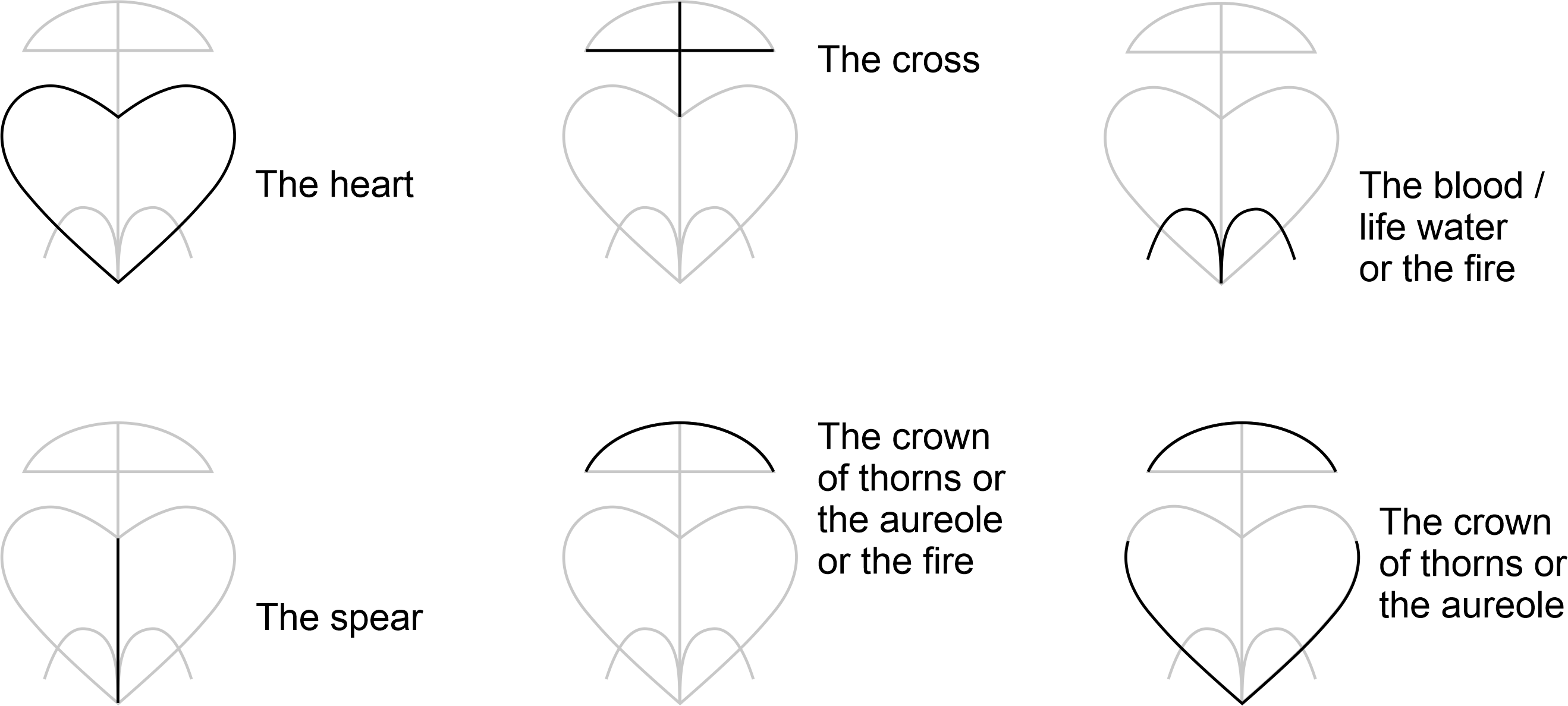
Figure 11.
Now Christianity is considered as an Abrahamitic religion, together with Judaism and Islam,36 and these three religions can also be symbolically recognized in the Mayil hieroglyph. The cross is of course the well known symbol of Christianity, but also the heart can be taken as a symbol of Christianity, for the heart symbolizes love and love is the central theme in Christianity.37 The fountain in the Mayil hieroglyph may further also be seen as symbol of the constellation of Aries or Ram. Now Aries was the era of Judaism, like Pisces is or was the era of Christianity,38 and the fountain in this consideration thus symbolizes Judaism. The dome then can be seen as a crescent moon, which has become the symbol of Islam,39 and so in this outlook the dome symbolizes that religion.
Here it is also interesting to lay relations with how the Mayil hieroglyph symbolizes the threefolds from the teachings of Bailey. As we saw the dome symbolizes spirit and power, the heart consciousness and love and the fountain matter and intelligence, and these givens we also recognize in the orientations of the mentioned Abrahamitic religions. Judaism orients itself on materiality and intelligence,40 Christianity on love, and Islam, thus is here inferred, orients itself on the imposing of the will of God through power.

Figure 12.
Now it is so that Christianity came forth from Judaism, and the offspring of the ram regards the lamb. Then it is striking that Christ is also called the 'Lamb of God' (or in Latin 'Agnus Dei').41 This Lamb of God is usually depicted as a lamb that holds a wooden cross. Often the lamb has a wound in its chest from which flows blood, and not rarely the lamb is depicted as lying on a book with seven seals. Almost always the lamb also has an aureole or halo around its head. Symbolically with the entirety of this image the blessing giving sacrifice of Christ is depicted. The lamb regards Christ as sacrificial lamb that took on itself the cross. The wound that was inflicted with the sacrifice of the lamb brings forth the blood and the life water of Christ. The book with the seven seals stands for the revelations of God.42 The aureole or halo stands for the holiness of Christ and the from Him outgoing blessings.
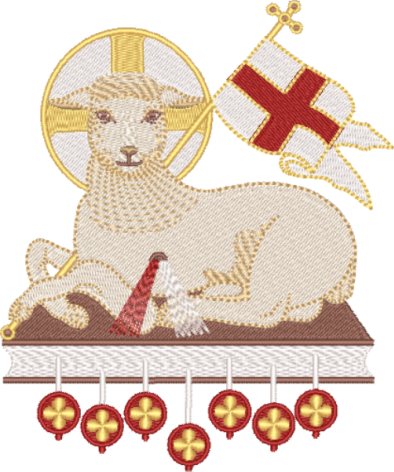
Figure 13.
This Lamb of God as described above may also be seen in the Mayil hieroglyph. The fountain may thereby as Ram symbol also stand as a symbol for the Lamb, being the Christ. In the cross, starting from the fountain, and the dome we thereby easily see the cross and the aureole of the Lamb of God and the heart then shows us the heart of Christ that was pierced. In another outlook we see the fountain as a frontal view of the opened book of revelation. In that case we see the heart, being as mentioned a symbol of the Christ, as the Lamb of God. Things connect with regards to symbology of course closely to the Sacred Heart symbology. The fountain for instance may again be seen as the blood and life water of the Christ, but then the Lamb of God symbology rather makes place for the Sacred Heart symbology.
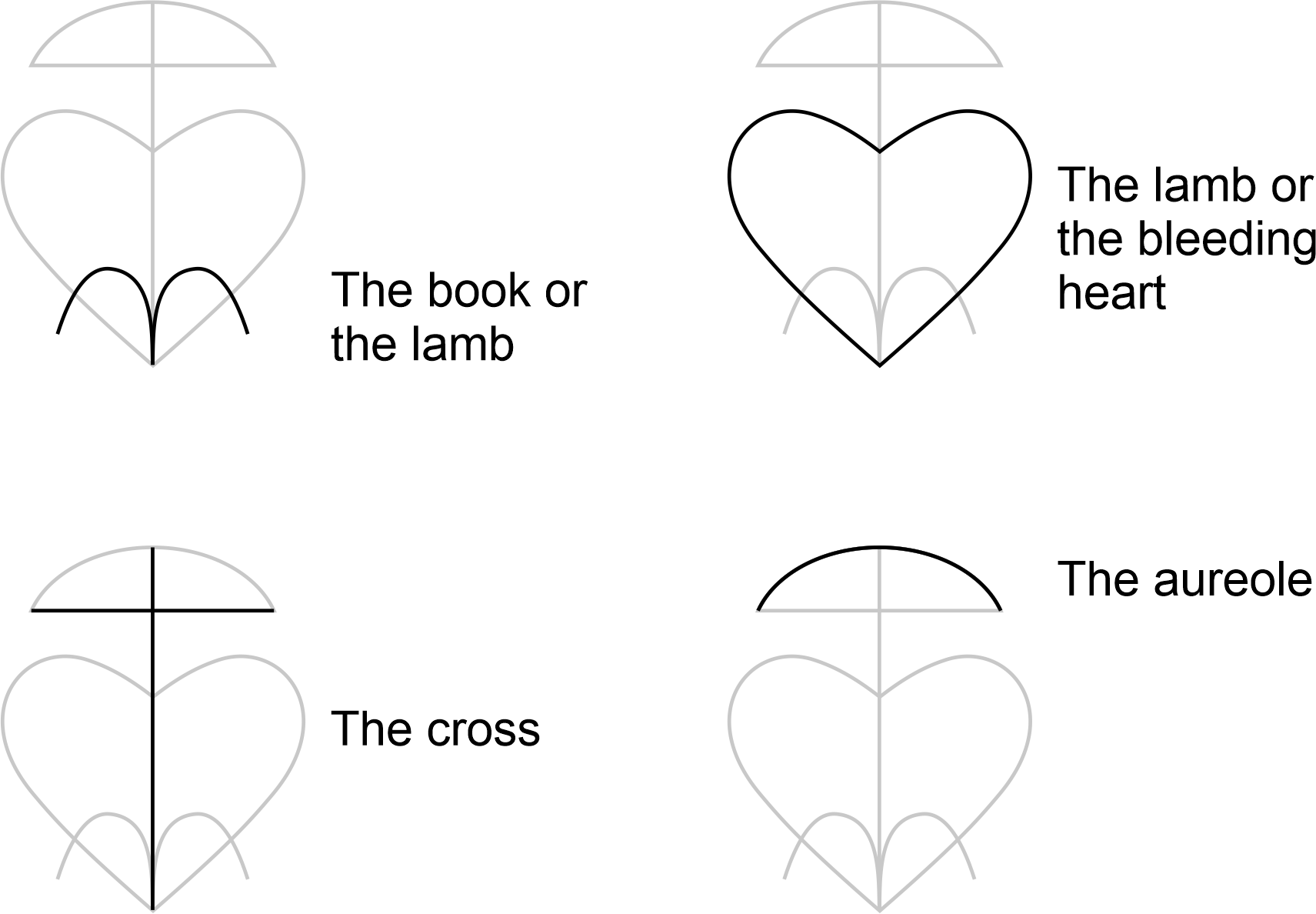
Figure 14.
Within the theme of Christianity may in the Mayil hieroglyph further also the symbols be found of the three Christian virtues of faith, hope and love.43 Traditionally thereby is faith symbolized by a Christian cross, love by a heart and hope by an anchor. That cross and that heart are of course clearly present in the Mayil hieroglyph, and the anchor can be seen in the vertical line through the heart together with the lines of the fountain that for a more convincing depiction could be flipped. That thereby hope has its core in the materiality of the fountain and faith in the spirituality of the dome is befitting. For standing in only materiality one can only hope for divine intervention, however standing in spirituality one may also actually put faith in the everything to being bringing divinity, because of which one thus does not need to hope anymore.44 And it is then the in between standing love that transforms hope to faith. Expressed differently it is the intelligence that delivers hope, power that delivers faith and love that transforms the first to the latter.

Figure 15.
Now above the Mayil hieroglyph was thematized in its symbology of the Abrahamitic religions, however with some fantasy also the aum-sign of Hinduism and Buddhism can be constructed.
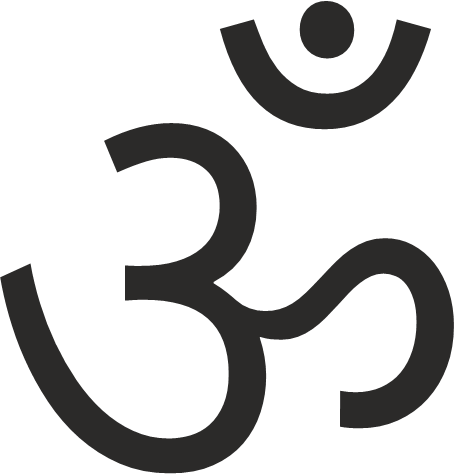
Figure 16.
Connecting to the Sanskrit script the bows of the heart are thereby taken as 'a', a bow of the fountain as 'u' and the bow of the dome with the central point of the cross as 'm'. It is however also possible to connect to the Latin script. In this case the (extended) bow line of the dome and the horizontal line of the cross form the character 'a', the two straight lines of the heart the character 'v' (which phonetically is akin to the character 'u')45 and the two bow lines of the fountain the character 'm'. Interesting to mention hereby is that it was earlier already contemplated that in 'aum' the 'a' resonates with spirit, the 'm' with matter and the 'u' with the mediating principle,46 and this is thus in line with the principles that the Mayil hieroglyph may also symbolize.
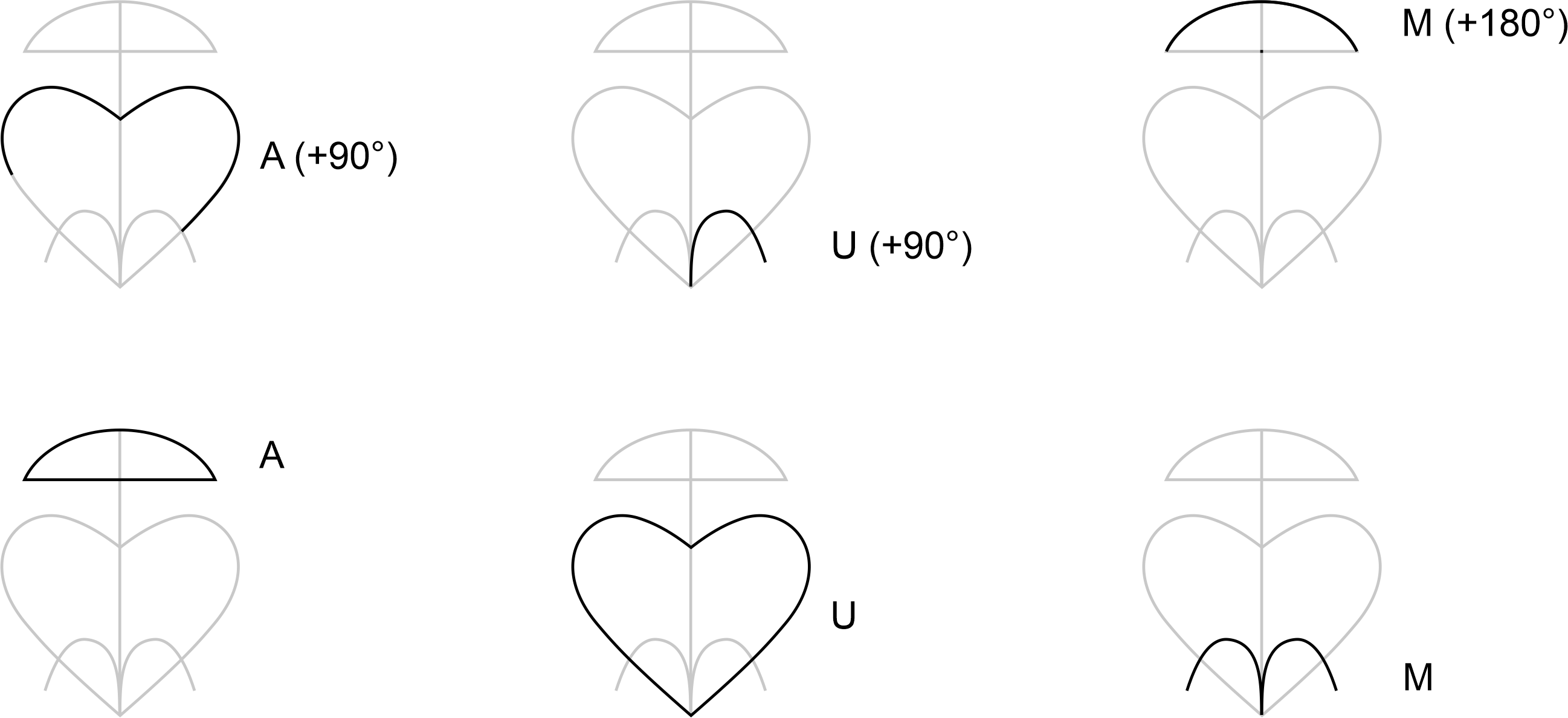
Figure 17.
Now this contemplation was started with the mentioning of the "Mayil Hieroglyphica", and this term is a derivation of the 'Monas Hieroglyphica' as mentioned and described by Ioannis or John Dee (1527-1608/1609).47 This term 'Mayil Hieroglyphica' was derived from 'Monas Hieroglyphica' due to the great resemblances that the Mayil hieroglyph has with the monadic hieroglyph. Dee was among other things an esotericist.48 Below the Monas Hieroglyphica is shown.
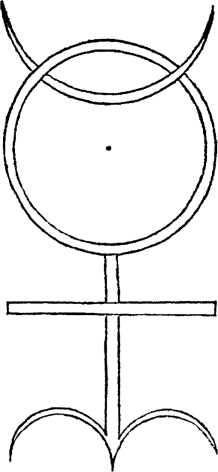
Figure 18.
We see the Monas Hieroglyphica of Dee from top to bottom consisting of a downward bent line, a circle with in it a point, a cross and two upward bent lines. The Mayil Hieroglyphica contains from top to bottom also a bent line, be it that this one is bent upward, a cross, be it that this one is placed above the central symbol, and two upward bent lines. Instead of a circle with a point the Mayil Hierglyphica contains a heart shape and a vertical line that also can be seen as an extension of the cross.
Dee interprets his Monas Hieroglyphica initially very astrologically. The top bent line symbolizes the moon, the circle with the point the sun, the cross the four elements and the two bottom bent lines form together the symbol of the Aries or Ram constellation, which according to Dee stands for fire. The top bow line and the circle together form however also the symbol of the Taurus or Bull constellation, and when the cross to that is added then the symbol of Mercury is formed. Without the top bow line one arrives at the symbol of Venus. By taking the cross together with the right bottom bow line one arrives at the symbol of Saturn, and when the cross is taken together with the left bottom bow line one arrives at the ninety degrees tipped over symbol of Jupiter. In the taking together of the vertical line of the cross with the two bottom bow lines an arrow form can be seen, and when connected to the circle a hundred and thirty five degrees tipped over symbol of Mars is formed. When further the Venus symbol is vertically mirrored then also a symbol for the planet Earth is formed, however this is not treated by Dee. He does still treat many other things about the Monas Hieroglyphica, but those cannot be treated here.
Departing from the graphic similarities it can be seen that the Mayil Hieroglyphica contains the moon symbol with the vertically mirrored top bow line, the elements symbol with the cross, the Aries or Ram symbol with the bottom two bow lines, but also the Jupiter symbol with the left bottom bow line and the cross and the Saturn symbol with the right bottom bow line and the cross. The astrological signs that in the Monas Hierglyphica contain the circle cannot be constructed from the Mayil Hieroglyphica, however there are strong connections between the Sun symbol and the heart symbol. For the heart is the symbol of love and love is the most important quality of the soul,49 and the sun is itself also a symbol of the soul.50 So where the Monas Hieroglyphica uses the Sun symbol to (either consciously or not) symbolize the soul there the Mayil Hieroglyphica uses for that (also either consciously or not) the heart symbol. Graphically it is further interesting to mention that when the circle of the Monas Hieroglyphica is broken open like an egg, the point like a yolk comes to fall beneath the two half circles. When these half circles then are connected with the point the heart shape of the Mayil Hieroglyphica comes to being. In conclusion may the bow line of the dome also be taken together with left and right the two outer lines of the heart, through which a periphery comes to being that contains a cross, which is an (imperfect) symbol of the planet Earth. (Take notice that the earth is symbolized by both a cross in a periphere circle and a cross on top of a circle.)
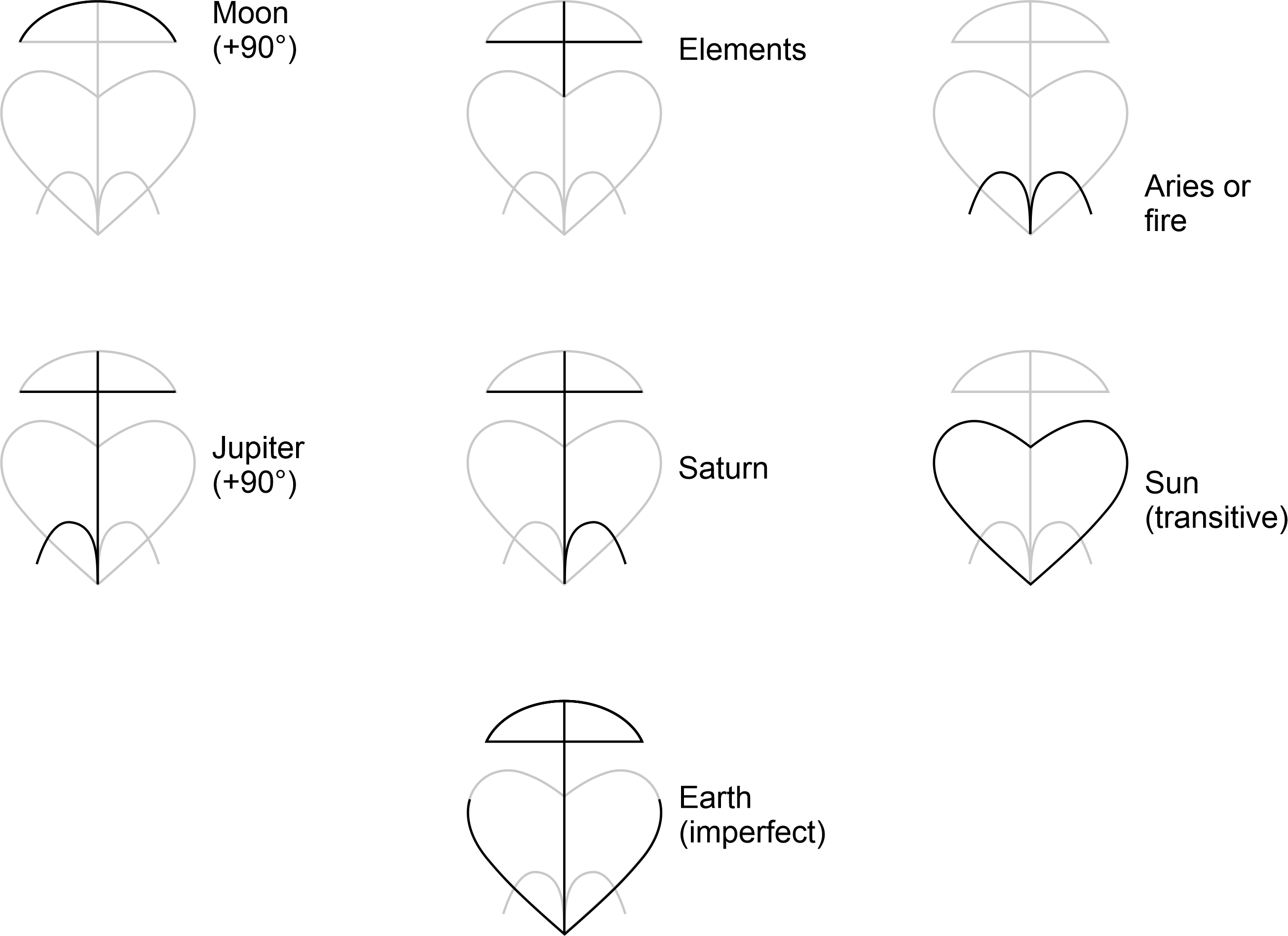
Figure 19.
With this we are then nearing the end of this contemplation on the Mayil hieroglyph. Having come to us from the work of Master Morya through Geert Crevits we descried in the Mayil hieroglyph similarities with the four forces, with Krishna's and Arjuna's chariot, with diverse threefolds as they were thematized by Master Djwhal Khul through Alice Bailey, with the Christian Trinity, with the Christian Sacred Heart symbol, with the symbology of the Abrahamitic religions, with the Christian Lamb of God symbol, with the Christian virtues symbolism, with the aum-sign of eastern religions, and concludingly with the Monas Hieroglyphica of John Dee. And contemplating the aforementioned we have not even been exhausting, for many aspects still stayed untouched. What then in the end at least can be concluded is that the Mayil hieroglyph, or the Mayil Hieroglyphica, is extraordinary rich in meaning and that it therewith is a rewarding subject for contemplation.
Notes
- Oxford English Dictionary, Second Edition on CD-ROM (v. 4.0), Oxford University Press, 2009, hieroglyph, n., 2.
- Ibidem, hieroglyph.
- John Ayto, Word Origins, The Hidden Histories of English Words from A to Z, A & C Black, London, 2005, p. 270.
- Mayil vzw, https://www.mayil.com/NL/boeken/sieraad.html, 23-12-2021.
- Ibidem.
- 'Contemplaties, Het kruis in de cirkel: bewustzijn en dualiteit', Index: 201510132.
- Mayil vzw, https://www.morya.org/NL/Geert_inmemoriam.html, 02-01-2022.
- Sri Swami Sivananda (editor / commentator), Bhagavad Gita, The Divine Life Society, Shivanandanagar, 2000, p. vii.
- Encyclopædia Britannica Ultimate Reference Suite, (CD-ROM), Encyclopædia Britannica, Chicago, 2010, Krishna.
- Alice A. Bailey, The Rays and the Initiations, A Treatise on the Seven Rays, Volume V, in: Twenty-Four Books of Esoteric Philosophy, (CD-ROM, Release 3), Lucis Trust, London / New York, 2001, p 91. "The Christ Who came two thousand years ago embodied in Himself not only the principle of love in the planetary sense (a thing which Shri Krishna had achieved), but a cosmic principle of love also, and this for the first time in human history."
- Bhagavad Gita, p. ix.
- Geert Crevits, Morya Wijsheid 3: God woont in je hart, Mayil Publishing House, 2010, p. 64. "Ik ben een krijgsheer geweest en Ik ben dat nog, maar Ik doe het op Mijn manier. Mijn wapen is de liefde, Ik vecht met liefde en Ik omring je met liefde."
- Alice A. Bailey, Initiation, Human and Solar, in: Twenty-Four Books of Esoteric Philosophy, (CD-ROM, Release 3), Lucis Trust, London / New York, 2001, p. 54. "The Master Morya, Who is one of the best known of the Eastern adepts, and Who numbers amongst His pupils a large number of Europeans and Americans, is a Rajput Prince, and for many decades held an authoritative position in Indian affairs."
-
Ibidem, p. xv.
"Will or Power The Father Love-wisdom The Son Active Intelligence The Holy Spirit." - 'Tijdloze wijsheid, Tripliciteiten in de mens', Index: 201308291.
- Alice A. Bailey, The Light of the Soul, in: Twenty-Four Books of Esoteric Philosophy, (CD-ROM, Release 3), Lucis Trust, London / New York, 2001, p. 353. "The seer has achieved the consummation of the alignment process. […]. Each of the three bodies is vibrating in tune with the note of the ego or higher self, which in turn is in process of synchronizing with the Monad or divine self, the spirit on its own plane."
- 'Tijdloze wijsheid, De (menselijke) centra', Index: 201909092.
- 'Tijdloze wijsheid, De draden', Index: 201504192.
- The Light of the Soul, p. 315. "It is this light which causes the "face to shine" and is responsible for the halo depicted around the head of all saints and Masters and which is seen by those with clairvoyant vision around the head of all advanced aspirants and disciples."
- 'Contemplaties, 'Ψ'', Index: 202104132.
- Alice A. Bailey, Esoteric Healing, A Treatise on the Seven Rays, Volume IV, in: Twenty-Four Books of Esoteric Philosophy, (CD-ROM, Release 3), Lucis Trust, London / New York, 2001, p. 165. "The heart, the love-wisdom of the soul, the buddhi or Christ principle."
- Devotion to the Sacred Heart, Including the Great Promise of the Nine First Fridays, (epub), TAN Books, Charlotte, 2012, ch. 4.
- Nota 6.
- Alice A. Bailey, From Bethlehem to Calvary, in: Twenty-Four Books of Esoteric Philosophy, (CD-ROM, Release 3), Lucis Trust, London / New York, 2001, p. 188. "Its form must be sacrificed upon the Cross of Christ in order that it may be resurrected into true and vital life for the meeting of the people's need."
- Nota 22.
- Alice A. Bailey, Esoteric Psychology, Volume I, A Treatise on the Seven Rays, Volume I, in: Twenty-Four Books of Esoteric Philosophy, (CD-ROM, Release 3), Lucis Trust, London / New York, 2001, p. 18. "This is the third aspect, the Mother, overshadowed and fertilised by the Holy Ghost, or Life, united with intelligent substance. This is fire by friction—[…]."
- Nota 14.
- The Light of the Soul, p. 331. "The explanation is given that the thorns are the cares and troubles of worldly existence […]."
- Nota 22.
- The American Standard New Testament, (software), Version 1.0, Ages Software, Albany, 1996, John, Ch. 19, v. 34 "howbeit one of the soldiers with a spear pierced his [Jesus'] side, and straightway there came out blood and water."
- 'Holy Lance' in: Encyclopedia Britannica, (internet), 29 maart 2021, https://www.britannica.com/topic/Holy-Lance/, 25-12-2021. "Holy Lance, also called Spear of Destiny, Holy Spear, or Lance of Longinus, legendary relic that pierced the side of Christ at the Crucifixion."
- The Rays and the Initiations, p. 766. "Key the third lies half way up. Just at the level of the heart that key is seen. Before it can be seized and used the spear must pierce and thus the blood pour forth, cleansing and making whole. Only those thus purified can grasp the key and pass through door the third."
- Pistis Sophia, The Theosophical Publishing Society, London, 1896, p. 375-376. "The fire, the water, and the wine are for cleansing all the sins of the world. […]. For this cause, also, they pierced my side with a spear, and there came forth water and blood."
- Devotion to the Sacred Heart, ch. 4.
- Nota 20.
- Encyclopædia Britannica Ultimate Reference Suite, monasticism, The Abrahamic religions.
- Alice A. Bailey, Problems of Humanity, in: Twenty-Four Books of Esoteric Philosophy, (CD-ROM, Release 3), Lucis Trust, London / New York, 2001, p. 123. "Christianity is an expression—in essence, if not yet factually—of the love of God, immanent in His created universe."
- Alice A. Bailey, The Reappearance of the Christ, in: Twenty-Four Books of Esoteric Philosophy, (CD-ROM, Release 3), Lucis Trust, London / New York, 2001, p. 81. "Christ came to bring to an end the Jewish dispensation which should have climaxed and passed away as a religion with the movement of the sun out of Aries into Pisces."
- Encyclopædia Britannica Ultimate Reference Suite, 'crescent'.
- Esoteric Healing, p. 267-268. "Let me point out also that just as the Kabbalah and the Talmud are secondary lines of esoteric approach to truth, and materialistic in their technique (embodying much of the magical work of relating one grade of matter to the substance of another grade), so the Old Testament is emphatically a secondary Scripture, and spiritually does not rank with the Bhagavad-Gita, the ancient Scriptures of the East and the New Testament. Its emphasis is material and its effect is to impress a purely materialistic Jehovah upon world consciousness. The general theme of the Old Testament is the recovery of the highest expression of the divine wisdom in the first solar system; that system embodied the creative work of the third aspect of divinity—that of active intelligence, expressing itself through matter."
- Encyclopædia Britannica Ultimate Reference Suite, Agnus Dei.
- The American Standard New Testament, Revelation.
- Ibidem, 1 Corinthians, Ch. 13, v. 13 "But now abideth faith, hope, love, these three; and the greatest of these is love."
- Ibidem, Mathew, Ch. 17, v. 20 "[…], If ye have faith as a grain of mustard seed, ye shall say unto this mountain, Remove hence to yonder place; and it shall remove; and nothing shall be impossible unto you."
- Oxford English Dictionary, U.
- 'Contemplaties, De Fractalheid van 'Aum Tat Sat'', Index: 201107192, Aum Tat Sat, Aum.
- Ioannis Dee, Monas Hieroglyphica, Apud Ioannem Wechelum & Petrum Fischerum consortes, 1591.
- Joseph H. Peterson (editor), John Dee's Five Books of Mystery, Original Sourcebook of Enochian Magic, Red Wheel / Weiser, York Beach, 2003, Introduction.
- Nota 20.
- The Light of the Soul, p. 302. "If the student will remember that the moon is the symbol of matter, whereas the sun in its aspect of light is the symbol of the soul, [...]."
Bibliography
- 'Contemplaties, De Fractalheid van 'Aum Tat Sat'', Index: 201107192.
- 'Contemplaties, Het kruis in de cirkel: bewustzijn en dualiteit', Index: 201510132.
- 'Contemplaties, 'Ψ'', Index: 202104132.
- 'Tijdloze wijsheid, De draden', Index: 201504192.
- 'Tijdloze wijsheid, De (menselijke) centra', Index: 201909092.
- 'Tijdloze wijsheid, Tripliciteiten in de mens', Index: 201308291.
- John Ayto, Word Origins, The Hidden Histories of English Words from A to Z, A & C Black, London, 2005.
- Alice A. Bailey, Esoteric Healing, A Treatise on the Seven Rays, Volume IV, in: Twenty-Four Books of Esoteric Philosophy, (CD-ROM, Release 3), Lucis Trust, London / New York, 2001.
- Alice A. Bailey, Esoteric Psychology, Volume I, A Treatise on the Seven Rays, Volume I, in: Twenty-Four Books of Esoteric Philosophy, (CD-ROM, Release 3), Lucis Trust, London / New York, 2001.
- Alice A. Bailey, From Bethlehem to Calvary, in: Twenty-Four Books of Esoteric Philosophy, (CD-ROM, Release 3), Lucis Trust, London / New York, 2001.
- Alice A. Bailey, Initiation, Human and Solar, in: Twenty-Four Books of Esoteric Philosophy, (CD-ROM, Release 3), Lucis Trust, London / New York, 2001.
- Alice A. Bailey, Problems of Humanity, in: Twenty-Four Books of Esoteric Philosophy, (CD-ROM, Release 3), Lucis Trust, London / New York, 2001.
- Alice A. Bailey, The Light of the Soul, in: Twenty-Four Books of Esoteric Philosophy, (CD-ROM, Release 3), Lucis Trust, London / New York, 2001.
- Alice A. Bailey, The Rays and the Initiations, A Treatise on the Seven Rays, Volume V, in: Twenty-Four Books of Esoteric Philosophy, (CD-ROM, Release 3), Lucis Trust, London / New York, 2001.
- Alice A. Bailey, The Reappearance of the Christ, in: Twenty-Four Books of Esoteric Philosophy, (CD-ROM, Release 3), Lucis Trust, London / New York, 2001.
- Geert Crevits, Morya Wijsheid 3: God woont in je hart, Mayil Publishing House, 2010.
- Ioannis Dee, Monas Hieroglyphica, Apud Ioannem Wechelum & Petrum Fischerum consortes, 1591.
- Joseph H. Peterson (editor), John Dee's Five Books of Mystery, Original Sourcebook of Enochian Magic, Red Wheel / Weiser, York Beach, 2003.
- Sri Swami Sivananda (editor / commentator), Bhagavad Gita, The Divine Life Society, Shivanandanagar, 2000.
- Devotion to the Sacred Heart, Including the Great Promise of the Nine First Fridays, (epub), TAN Books, Charlotte, 2012.
- Encyclopædia Britannica Ultimate Reference Suite, (CD-ROM), Encyclopædia Britannica, Chicago, 2010.
- 'Holy Lance' in: Encyclopedia Britannica, (internet), 29 maart 2021, https://www.britannica.com/topic/Holy-Lance/, 25-12-2021.
- Mayil vzw, https://www.mayil.com/NL/boeken/sieraad.html, 23-12-2021.
- Mayil vzw, https://www.morya.org/NL/Geert_inmemoriam.html, 02-01-2022.
- Oxford English Dictionary, Second Edition on CD-ROM (v. 4.0), Oxford University Press, 2009.
- Pistis Sophia, The Theosophical Publishing Society, London, 1896.
- The American Standard New Testament, (software), Version 1.0, Ages Software, Albany, 1996.